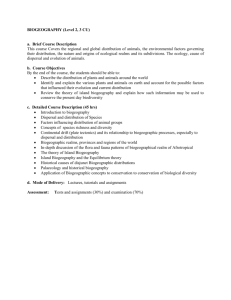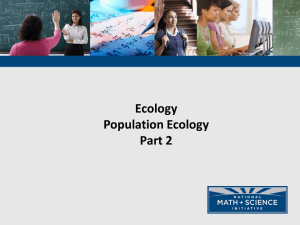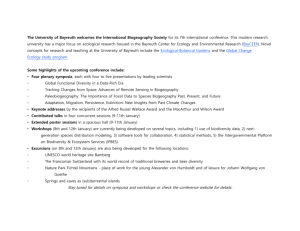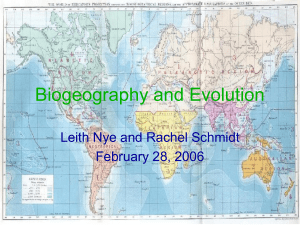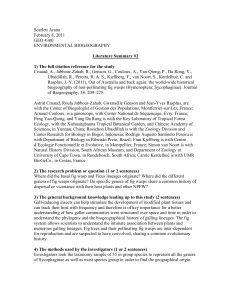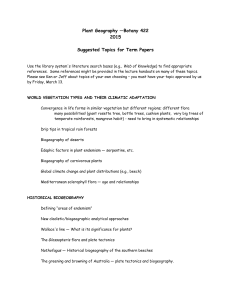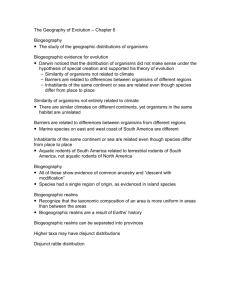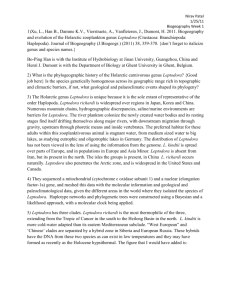KGA172_L2.10_final - School of Geography and Environmental
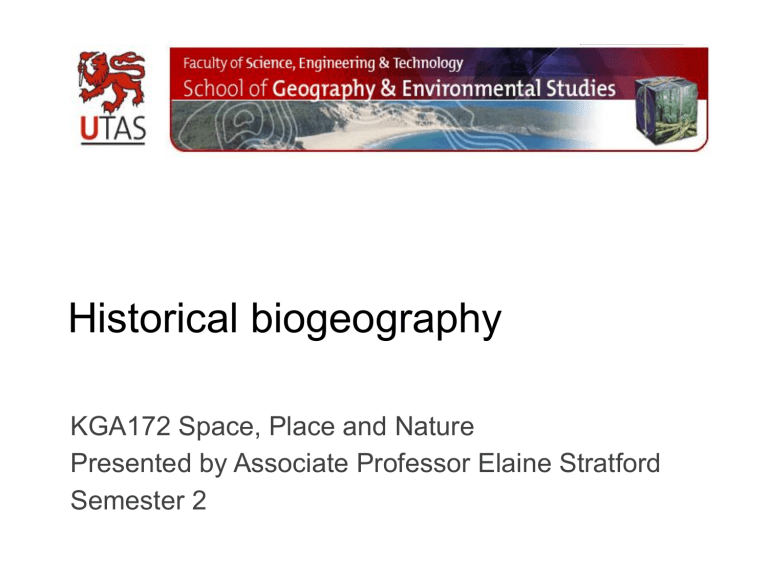
Historical biogeography
KGA172 Space, Place and Nature
Presented by Associate Professor Elaine Stratford
Semester 2
Part 1
LOOKING BACK, LOOKING
FORWARD
Revising Lecture 2.9
1. Name and define six elements of ecosystem function.
2. What are the key differences between habitat and niche? In practical terms, why is it important to understand these differences?
3.
Explain the concept ‘potential’ niche. How does that differ from ‘realized’ niche?
4. Name, describe and explain the interrelationships among three key limits on biota, providing examples for each.
5. Using light as your focus, describe and explain the interrelationships among growth, productivity and competition.
6. In what ways is water both an environmental condition and resource?
7. How and why is it important that environmental studies is an area of multi-
[and even inter-] disciplinary study?
A Woman Thinking
Learning Objectives
Module 2 Lecture 10
• be able to describe and explain a range of ideas and cite a range of examples to show understanding of:
– biotic realms
– relicts
– continuous and disjunct distributions
– centres of local endemism
– pangeographic nodes
– refugia
KGA172
•
Know and be able to (a) employ basic geographical terminology and concepts,
(b) find, evaluate, analyse and reference appropriate literature, (c) contribute to debates about development and sustainability
• Comprehend and be able to explain spatial patterns, generate basic maps, field sketches and graphs, and communicate in written and graphical forms
• Apply key academic skills and (a) engage in critical thinking, discussion and listening, and in self-reflection and reflection upon the viewpoints of others and (b) research, plan and conduct fieldwork to collect data
•
Analyse and interpret basic spatial, numerical and qualitative information
• Synthesize and integrate knowledge of social and Earth systems
Textbook Reading
.
Bergman and Renwick (2008) graze through parts of chapter 4.
Critical reading
1.
What is the author’s purpose?
2.
What key questions or problems does the author raise?
3.
What information, data and evidence does the author present?
4.
What key concepts does the author use to organize this information, this evidence?
5.
What key conclusions is the author coming to? Are those conclusions justified?
6.
What are the author’s primary assumptions?
7.
What viewpoints is the author writing from?
8.
What are the implications of the author’s reasoning?
[from Foundation for Critical Thinking ]
Old Woman Reading a Lectionary , Gerard Dou
Part 2
KEY IDEAS IN HISTORICAL
BIOGEOGRAPHY
Kirkpatrick 1999
Biotic realms
Relicts
Continuous and disjunct distributions
Centres of local endemism
Pangeographic nodes
Refugia
Biotic realms
Joy Tivy (1982) Biogeography. 2nd ed. Longmans.
1.
Boreal
2.
Palaeotropical
3.
Neotropical
4.
Australian
5.
Antarctic influence
www.astrospringville.org
Joy Tivy (1982) Biogeography. 2 nd ed. Longmans.
Continuous and disjunct distributions
Myosotis de Bourbon, endemic to Reunion Island
Local endemism, pangeographic nodes, and refugia
Centres of local endemism
Dispersal and migration
Modes of dispersal and their effectiveness
Active dispersal
• Flight, perambulation, swimming
.
Passive dispersal
• wind, water, animal (endozoic and ectozoic)
Dispersal and migration
Martin Kellman (1980). Plant Geography. 2 nd ed., Methuen
.
Active dispersal
(Slide modified from one by Dr Emma Pharo)
Perambulation
www.kenyatravelideas.com
Swimming
[Atlantic Salmon]
(Adapted from slide by Dr Emma Pharo)
Barry Kovish
Passive dispersal - wind
Passive dispersal - Water
Ectozoic and endozoic animal transport
Factors affecting the probability of migration and the theory of island biogeography
Theory of island biogeography
Diagrams from McArthur and Wilson Theory of Island Biogeography
Roseate Froglet , Karri Froglet (Geocrinia rosea)
Distribution of alleles at the
Lgg locus
LOCATION
Genetic groups within
Geocrinia rosea
LOCATION allele A allele B allele C
0 20
Scale (km)
River
Coast
G. rosea range limits
N
Warren R
Don Driscoll
0
1
32
5 6
4
N
3
1
2
W
6
5
4
Warren R
20
1
3
2
D
5
6
4
2
G
4
1
5
6
3
2
S
1
3
Scale (km)
River
Coast
G. rosea range limits
N
The Hawaiian islands are a chain of volcanoes some 4,000km from the nearest continental land mass. Shown are the central islands of Kahoolawe, Maui, Lanai,
Molokai and Oahu, from lower right to upper left. Source: P McQuillan
Source: P McQuillan
The rates of immigration and extinction differ with island size.
Hence the equilibrium number of species, or species richness
(S) differs between large and small islands.
Source: P McQuillan
The breakdown of biotic realms and kingdoms
(unknown)
Buchanan Bush Regeneration
